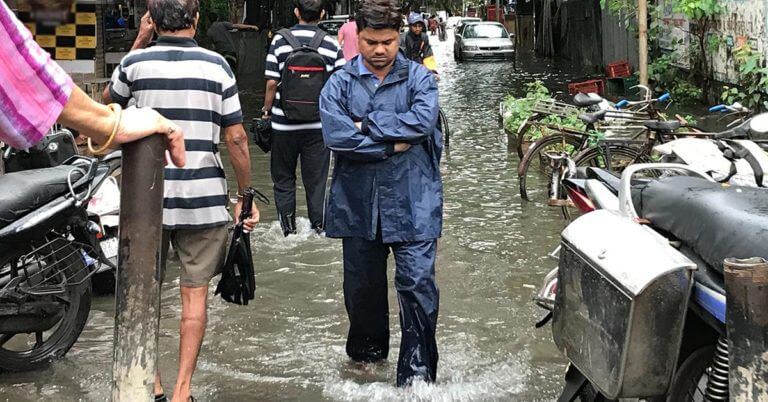The New Year saw torrential rainfall across Jakarta that triggered floods in all five municipalities. Of the 268 flooding spots flagged by the Indonesian National Board for Disaster Management, 158 were in Jakarta. TIME magazine reported that Jakarta’s rainfall alone was equivalent to 72,000 Olympic-size swimming pools. Images can be seen across the media of cars half-submerged, schools severely damaged and residents requiring rafts to get across muddy waters.
Over 20 million people are estimated to be living in the flood-prone areas and are at great risk of suffering health-related conditions. This problem is exacerbated by severe wealth inequality. A photo that has amassed over 24,000 retweets on Twitter shows an unaffected luxury swimming pool at Jakarta’s Shangri-La Hotel while the next-door village is submerged in muddy floodwaters. It is said that high-end development projects such as Shangri-La are 3 feet higher than street level, which causes floodwaters to flow down to nearby areas where poorer residents are unable to get help. According to Oxfam, Indonesia has the sixth greatest wealth inequality in the world.
What’s the solution?
Leaders are also facing mounting pressure of a capital city that is sinking. Some experts have claimed areas of North Jakarta are sinking up to 10 inches a year. The World Bank predicts the city could fall up to 16 feet below sea level by 2025. In August 2018, the Indonesian government announced plans to move the capital to the island of Borneo as overcrowding and pollution worsens, but the announcement, namely the cost involved, has generated some debate.
Disaster relief efforts
The Indonesian Red Cross has deployed thousands of volunteers to provide health services and emotional support to affected areas, and Indonesia’s National Disaster Management Agency has dispatched relief items and established evacuation centres for victims. Despite this, there is still a pressing need for humanitarian aid including baby diapers, blankets, tents, and mattresses. Poverty-stricken districts are particularly affected as poor families living in these areas lack access to infrastructure and even electricity. Efforts to locate missing people are also affected by mudslides, blackouts and lack of telecommunications.
Health risks
The aftermath could also spark transmission of life-threatening diarrhea, known as leptospirosis due to poor waste management. Clean water suppliers are critical as floodwaters carry raw sewage throughout the city and children are swimming in contaminated water. One solution is water purification system which are being distributed to make water safer to drink. Efforts are also in place to communicate to residents that treated water needs to be kept free from further contamination.
The capital has also been disinfected by military service people and health workers to prevent diseases from spreading. But, in addition to leptospirosis which is caused by the spread of rat urine, other diseases could surface including dengue and tetanus. The risk of the rapid spread of diseases is a concern as tens of thousands of people are displaced and living in cramped and damp shelters near piles of garbage. This puts breastfed babies at risk and can result in respiratory illnesses among all ages.
The impact
66 deaths have been confirmed and the Ministry of Health has reported over 100 injuries. Meanwhile, the ASEAN Coordinating Centre for Humanitarian Assistance has declared that over 36,000 people have been displaced from their homes, while other reports suggest this number could be as high as 90,000. What’s also concerning is that this number is expected to grow as high-intensity rainfall is predicted throughout January. To try and mitigate this occurrence and divert rain clouds, the country’s air force has attempted to use weather modification technology by seeding clouds with salt to minimise the downpour.
You might be interested in:
What’s really needed to improve access to healthcare in rural areas
In Southeast Asia, patients aren’t finishing their TB medications. Why?
